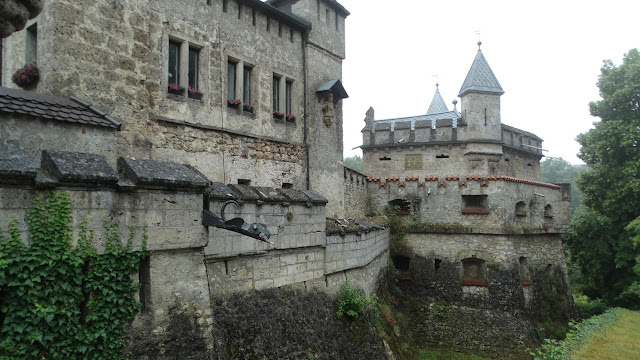Lichtenstein Castle (Schloss Lichtenstein) is a privately owned tourist attraction built in Gothic Revival style and located in the Swabian Jura of southern Germany. It was designed by Carl Alexander Heideloff and has been described as the "fairy tale castle of Württemberg."[2] It overlooks the Echaz valley nearHonau, Reutlingen in the state of Baden-Württemberg. The modern castle was inspired by the novel Lichtenstein (1826) by Wilhelm Hauff and was built in 1840-1842. The ruins of the medieval castle that inspired the novel are a few hundred meters away. The name Lichtenstein translates as "shining stone."[1
Hello My Dear Great Ones,
A few weeks ago Celia and I had the privilege of going to Schloss Lichtenstein with our aunt Heidi and cousin Birgit. It was fun being with them at such an amazing place. When we got there the castle was shrouded in fog, but it gradually lifted revealing its grandeur and incredible location. Perched on an edge of a cliff it has a commending view of the valley below. Well situated with an impressive armory to protect it Schloss Lichtenstein is tiny but tough.
The buildings near the main castle were impressive...
Whimsical and interesting carvings are everywhere on the castle grounds.
The Schloss "castle," coming into focus as the fog clears.
Hello My Dear Great Ones,
A few weeks ago Celia and I had the privilege of going to Schloss Lichtenstein with our aunt Heidi and cousin Birgit. It was fun being with them at such an amazing place. When we got there the castle was shrouded in fog, but it gradually lifted revealing its grandeur and incredible location. Perched on an edge of a cliff it has a commending view of the valley below. Well situated with an impressive armory to protect it Schloss Lichtenstein is tiny but tough.
Whimsical and interesting carvings are everywhere on the castle grounds.
The valley that the castle overlooks is impressive.
Getting to the Schloss was exciting. The bridge was rather precarious. We were not allowed to take any pictures inside but I managed to sneak in a few.
Germany is a land of castles. A trip there is not complete without visiting at least one castle.
Have a great week everyone!
Love adios and ping on!
Dirk




















































